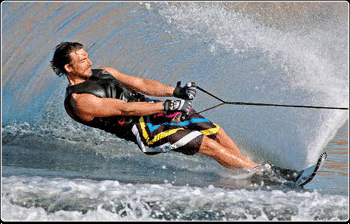
Why Do I Feel So Fast Into The Buoys
All of us at some point have had this thought cross our mind. It usually happens when a new line length or speed is first attempted or at the line length or speed that you are stuck on. It is a very bad feeling that usually is followed by a slack turn and hit from the rope. This inefficient approach can make the pass impossible and worse, can cause injury. Here is a look at why we feel fast.
The sensation of traveling too fast into a buoy is a combination of two major items. First is an overloading of the line before the wakes and the second is a lack of direction off the second wake. The first part causes the second part. Causes for excessive line load into the wakes stems from overturning (attempting to turn 90 degrees) or under turning (making a poor turn where the ski does not set enough angle). Ninety-nine percent of line loading stems from overturning. The majority of skiers I coach have it set in their head that they need to take the most angle they can out of the buoy. They believe this will give them the best opportunity to be early to the next buoy. This is not correct. Please read my ”Skiing the Impossible Line” article (July/August 2008) to help fill you in on this topic. The basic thing you need to know is that the boat is racing down the course at its set speed. You are connected to the boat that is traveling at that set speed. No matter how hard you try, you cannot turn 90 degrees AND go in that direction. Somewhere near 45 degrees is more reasonable to set your sights on. When a skier tries to take too much angle out of the buoy, the boat starts to fight them. The 330-horsepower engine will beat the skier every time. The harder you try to fight the boat, the more the boat will fight to beat you. When the boat beats you is the moment that you start to lose ski edge angle. The more you overturn, the quicker this will happen. The result of this loss to the boat IS edge change. The second wake or slightly thereafter – depending on how short of a line you are skiing – is the optimal edge change spot. Almost all skiers edge change too early. By the first wake, most skiers have started to lose ski edge angle and the edge change has started. This early loss of ski angle is a loss in ski direction into the next buoy.
When an early edge change occurs, the ski is rolled onto its turning edge too early. Thus it starts to turn too early. If the ski turns too early, we will not make the buoy and will either turn before the buoy or narrow of it! The quick fix for the early edge change is to stand up and flatten the ski as much as possible. This minimizes how much the ski turns before the buoy and gives you some width. This super narrow line is what makes you feel fast because you are traveling at a high rate of speed right at the buoy! A ski that is flat is hard to turn in a controlled manner. It will tend to dump the skier and over rotate (skid out). Both of these things cause excessive line loading and now the process has started again for the next edge change.
Understanding that you are caught in a never ending battle that you cannot possibly win is the first step to fixing the problem. Next is to know why it is happening (this article). After that you need to know what the solution is (Skiing the Impossible Line”). Finally, after all of this, practice is what will fix the problem. Take some time to visualize what you want to ski like. The clearer the picture is in your head, the more you understand what you want to do, and the easier it will be to learn the new technique.

















